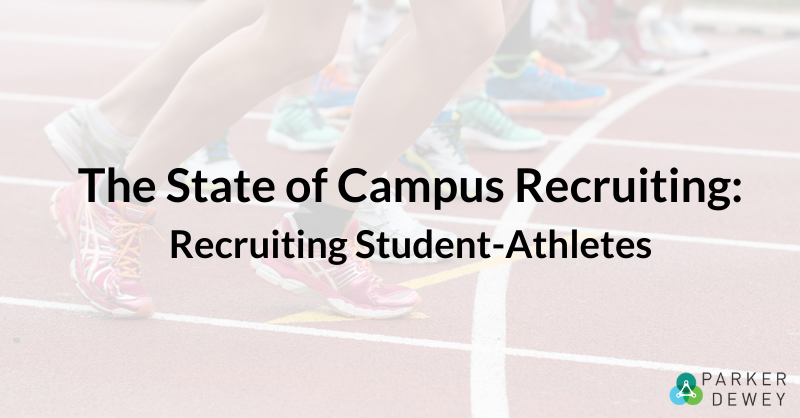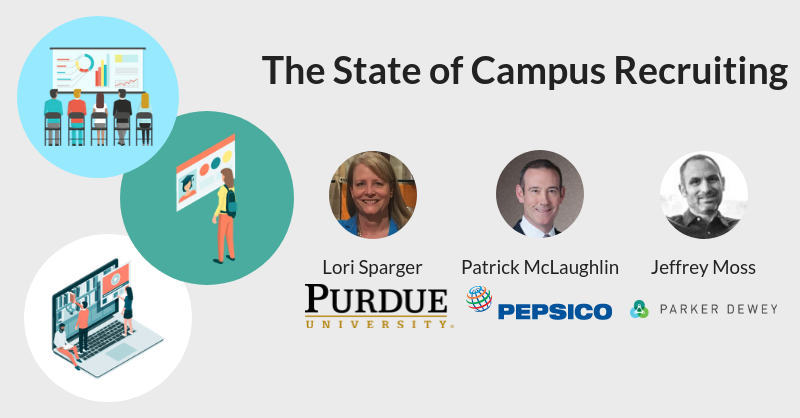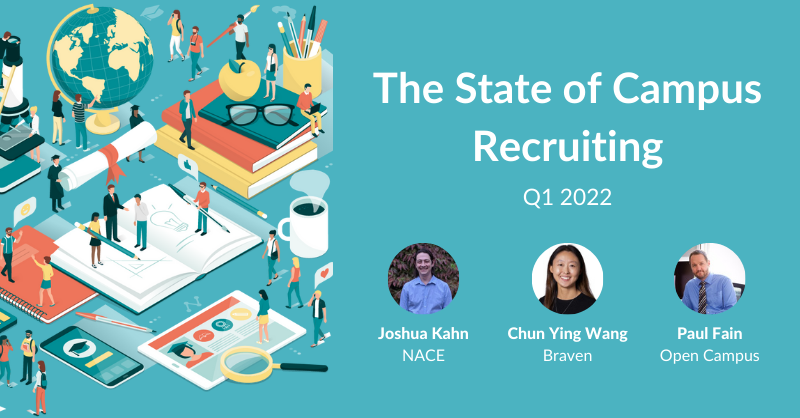
Spring 2021: Recruiting Student-Athletes
Looking for the webinar replay? Find it here!
There’s been much discussion about the key competencies of successful campus hires - do they have the skills to thrive, learn quickly, and lead? As a result, many companies talk about their desire to recruit and hire athletes that demonstrate these skills and more on and off the field. While there’s a general appreciation for what student-athletes can bring to the workplace, many of them get left behind and struggle to find both experiential learning opportunities and full-time roles after graduation.
In our spring 2021 edition of The State of Campus Recruiting, Jeffrey Moss (Founder & CEO, Parker Dewey), Amanda Brown (Assistant Director, Career Enhancement & Employer Relations, Northwestern University - Athletics), Tony Denhart (University Relations Director, GE), and Kelly O’Sullivan (Campus Recruitment, AlphaSights) discussed the recruiting challenges faced by companies and students alike, strategies to address these challenges, and how these strategies can be applied to other student populations as well.
The following is a synopsis of the conversation, including some of the key takeaways and quotes from the panelists. In addition, the replay is now available on-demand.
Engaging Student-Athletes in Career Exploration
Despite being sought-after by employers, many student-athletes run into a wall when it comes to employers fully understanding their commitments.
Kelly: Student-athletes are high value at all levels of organization, from entry-level to leadership. Their grit, ability to handle difficult situations, and adaptability all lend themselves to high performance.
Tony: Recruiting athletes is part of our strategy across all campuses. But it’s a marathon, not a sprint: it takes years to build relationships and we need to educate our team internally that these candidates bring so much to the table.
Amanda: Our students often feel like they can’t do both in terms of athletics and advancing their career preparation, so companies need to build trust and show their willingness to work with them and their schedules. We’re here to help equip students and direct them to resources, but ultimately they are responsible for their own path. We try not to do it for them, but empower them to opportunities to learn and grow.
Tony: As recruiters, we have to be able to work with students around their schedules, help them get prepared and get to know them. We also have to let our managers and leaders understand that this is a great hire, but it takes some innovative thinking to catch them.
Kelly: Yes, we have to be creative and meet halfway. Maybe it’s hosting a breakfast or a late night info session that works with the student-athlete’s schedule. We all have Zoom fatigue, so students should be proactive on LinkedIn and Handshake so we can find you.
Building Meaningful Relationships Online: Creativity & Communication
Tony: It was just last year when we flipped 80% of our internships to remote/virtual formats. It took work and we had to be focused and have a plan. When we could travel, I’d make a point to stop by an office and host an intern roundtable. Without travel, we had to be purposeful in reaching out. Luckily, we were able to build many relationships before the pandemic, but we had to be consistent when we moved online.
Kelly: We had to demonstrate our adaptability and listen to feedback from pros like Amanda to hear where the students were at. We tried to do as many virtual events as we could, which meant we had to creatively get around Zoom fatigue: tapping alumni, campus ambassadors, and past interns to meet with students in shorter time blocks, stopping into [virtual] club meetings for casual meet and greets, and trying to find different blocks of time for intro calls. Collecting feedback from candidates meant we couldn’t get attached to any previous ideas.
Amanda: There was a lot of uncertainty and anxiety [last summer] from our students but it was a bond that brought us together. Companies are still trying to figure out what’s going to be viable, so we had to help our students be patient, be flexible, and look for creative options.
Tony: There was a lot of uncertainty! We communicated with students and there were people inside the company that thought I was over-communicating, but the data showed we weren’t. Even if we didn’t know anything, we communicated on a consistent basis. If we said we would get back in two weeks and didn’t have an update, we let them know that two weeks later as promised.
Amanda: Communication goes a long way with students. Living in ambiguity is very stressful and any update goes a long way and leaves a good impression.
Filtering Out Versus Welcoming In
For some student-athletes, as well as students with responsibilities outside of academics, GPA can be a limiting factor in their job search. Our panelists shared both how employers can look past this divisive screening tool, and what they can do instead to narrow down applicants without limiting access.
Kelly: The more students are able to talk about their experiences as an athlete, it helps us understand why a GPA might be lower than our requirement, or why they may be lacking in relevant experience, and helps demonstrate their successes.
Amanda: To help students tell their story better we tell them to think about an onion. You can balance school and athletics, peel that back and tell us why that’s a good skill, why is that important to a job you’re applying to? We push them to keep going deeper until they have that lightbulb moment and see how what they are doing today connects with the careers they are applying for.
Tony: Yes, you have to know the whole story and dig deeper than GPA to understand the candidate’s journey to know what they have been through. Let’s also think about students working 50 hours per week to put themselves through school. We’ve historically had a minimum GPA, so it’s a challenge to change some manager’s minds over the requirement, but we found success by going back to student-athletes we hired in the past as an example.
Kelly: Beyond GPA, feedback and failure are huge for our client-facing positions. You can expect some clients will be more difficult than others, so managers of our entry-level hires are excited to hear examples of resiliency. Student-athletes are also very results-oriented. The candidates that can delve into their experiences more deeply go onto the next round.
Tony: We have to help other employers and managers understand the value of these candidates. There are nearly 500,000 NCAA students and fewer than 2% go on to be pro. That’s 490,000 student-athletes looking for jobs after graduation. There are a lot of great students we’re missing. Employers need to be open to non-traditional approaches. There are opportunities throughout the year, like Micro-Internships, that fit a student-athlete’s schedule. Any time we can encourage our employees to develop relationships with candidates is a win.
Amanda: Leaning into the alumni network is key, too! The students don’t want to hear this advice from us. It’s more impactful when it’s peer to peer learning, “I walked in your shoes. I get it. Here’s how I navigated it and here’s how this company supported me when I was a student-athlete.”
Final Advice for Employers & Universities
Kelly: For employers, you’re aware of the value your organization can provide, but we need to be willing to meet people halfway. Universities can develop creative programming: breakfast info sessions, skill building sessions. It’s low-risk and easy to try.
Tony: For universities, pick two companies and host a student-athlete or non-traditional student event. Help educate us on why we should be recruiting these students as part of our strategy. For employers, think outside of the box. An athlete won’t be able to do a traditional summer internship, but they could do two Micro-Internships throughout the year.
Amanda: For employers, flexibility is key. You have to think outside of your structured program to get this talent into your pipeline. For schools, don’t be afraid to advocate for student-athletes while helping them take ownership. Both sides need to show empathy and put ourselves in the shoes of the student.




